When it comes to teardrop camper construction, selecting the right material is crucial for durability, weight, and overall performance. Three popular methods include wood, fiberglass mould, and composite panel construction. In this blog, we’ll delve into the pros and cons of each method to help you make an informed decision for your teardrop camper project.
Wood Construction

Pros
Traditional Aesthetics
Wood’s warm and natural appearance imparts a timeless and classic aesthetic to teardrop campers, appealing to those with a penchant for nostalgia. The charming, rustic allure of wood creates a unique visual appeal that stands out in the camping community.
Customisation
Wood’s versatility allows for unparalleled customization potential, making it an ideal choice for those who seek a camper with a personal touch. The ease with which wood can be worked allows for intricate designs, personalized details, and the incorporation of specific wood types, providing a canvas for creative expression.
Repairability
One of wood’s standout features is its ease of repair. In the event of damage, whether due to impact or wear, repairing or replacing wooden components is often straightforward and cost-effective. This makes wood an excellent choice for those with a DIY mindset, fostering a sense of self-sufficiency and hands-on involvement in the maintenance of the camper.
Biodegradability
An additional environmental consideration is wood’s natural biodegradability. Unlike synthetic materials, wood decomposes over time, leaving a smaller ecological footprint. This eco-friendly aspect may resonate with campers aiming for a more sustainable and Earth-conscious approach to their outdoor adventures.
Cons
Weight
Despite its aesthetic and customizable advantages, wood tends to be heavier than alternative materials, impacting the overall towing experience and fuel efficiency. This can be a crucial consideration for campers with smaller vehicles, as the added weight may limit mobility and increase fuel consumption during travel.
Maintenance
Wood requires consistent and diligent maintenance to preserve its longevity. Exposure to the elements can lead to issues such as rot, warping, or insect damage, necessitating regular inspections and treatments to ensure the structural integrity and appearance of a wood-constructed teardrop camper.
Weather Sensitivity
Wood is susceptible to weather conditions, particularly moisture. Prolonged exposure to damp environments can result in swelling, decay, or other forms of damage. To mitigate these effects, sealing and protective coatings become essential, adding an extra layer of maintenance responsibility for owners.
Cost Considerations
While the upfront cost of wood may be lower than some alternatives, factoring in the ongoing maintenance and potential repairs is crucial. Campers should weigh the initial investment against long-term costs to determine the overall financial impact of choosing wood as a construction material.
FibreGlass Mould Construction
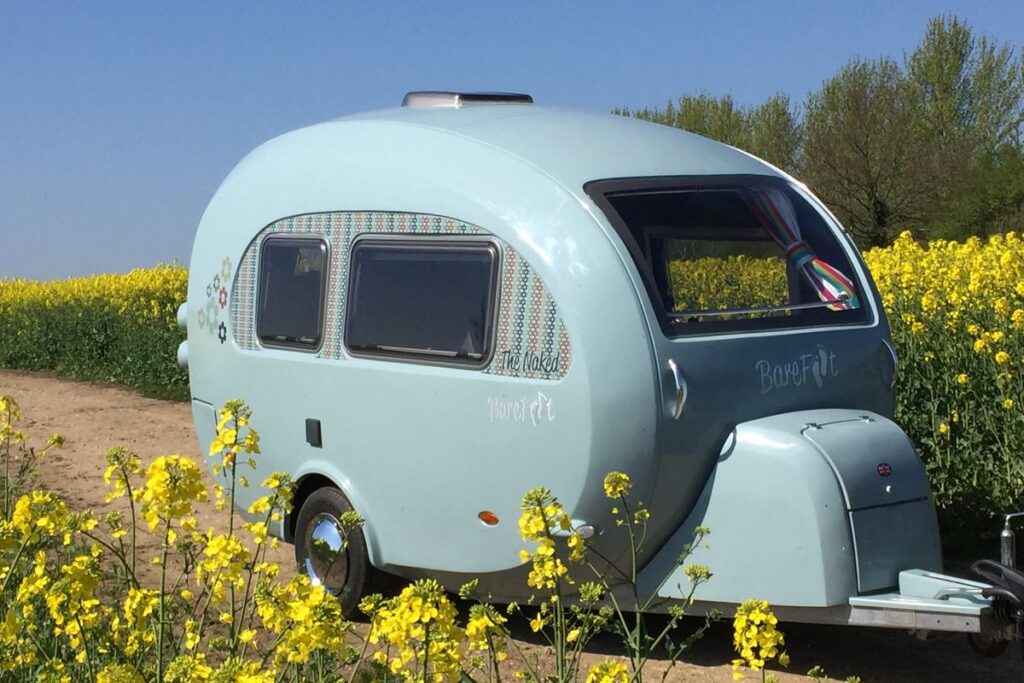
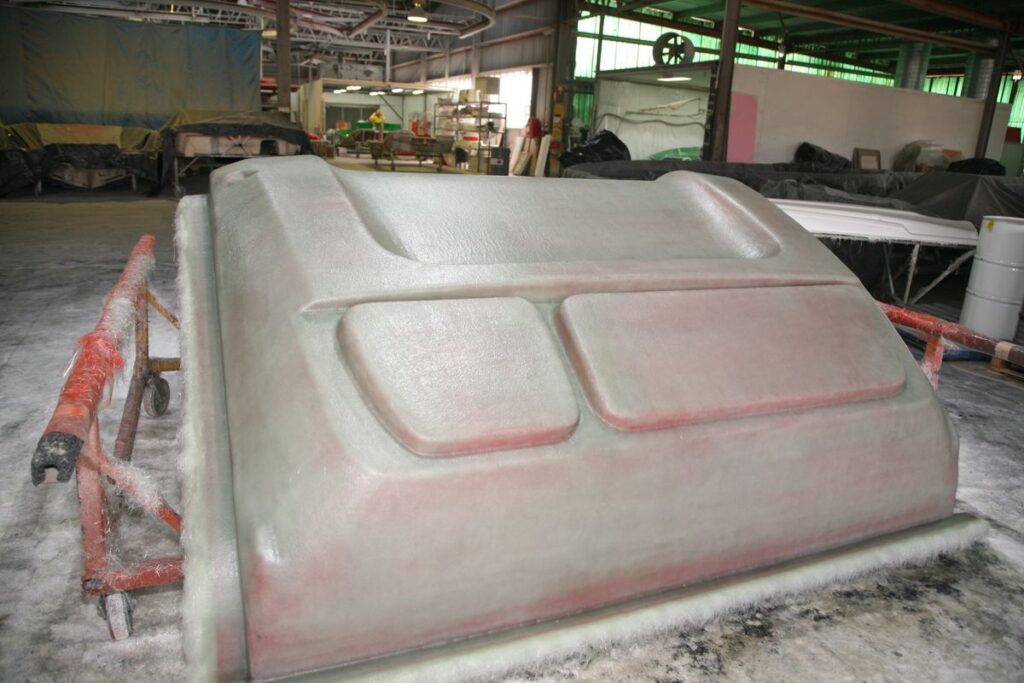
Pros
Lightweight
Fiberglass builds are celebrated for their lightweight properties, contributing significantly to improved fuel efficiency and facilitating easier towing. These properties are due to fibreglass composite materials amazing strength-to-weight ratio. This advantage enhances the overall mobility of the camper, making it an attractive option for those who prioritize a seamless and unencumbered travel experience.
Durability
Fiberglass is highly durable, providing resistance against moisture, rot, and damage from insects. The camper’s structural integrity remains intact over time, offering a reliable and long-lasting solution for camping enthusiasts who seek a robust and resilient build.
Low Maintenance
Fiberglass requires minimal maintenance compared to some other materials. The non-porous surface resists moisture absorption, reducing the likelihood of issues like rot or mold. This low-maintenance characteristic can be particularly appealing to campers seeking convenience in their outdoor adventures.
Cons
Limited Customisation
Customisation options of moulded fibreglass builds tend to be very limited when compared to wood constructed teardrop campers. This is due to an expensive mould being required to form the fibreglass shape. The mould once made is very difficult to modify and certaintly not worth it to manufacturers to change for any individual customisation request. The use of a mould lends extremely well to mass producing 1000’s of identical campers in a cost-effective manner, but doesn’t allow for individual customisation.
Repair Complexity
Fiberglass repair can be a much more intricate and messy process than working with wood, with a perfect finish being extremely hard to achieve by DIY’ers. In the event of damage, seeking professional assistance is almost always necessary, potentially resulting in significantly higher repair costs. This complexity can be a deterrent for DIY enthusiasts who prefer a hands-on approach to maintenance and repairs.
Cost
Due to requiring a mould, fibreglass constructed teardrop campers are extremely financially, time and skill prohibitive to the majority of teardrop builders. The material lends itself better to manufacturers who plan to make hundreds, thousands or even tens of thousands of campers, who can offset the initial cost of mould construction by the time and money saved on each individual unit sold in mass production.
Environmental Impact
Fiberglass is a synthetic material that raises environmental concerns during both production and disposal. Campers with a strong commitment to eco-friendly practices may find this aspect of fiberglass construction less aligned with their sustainability goals.
Composite Panel
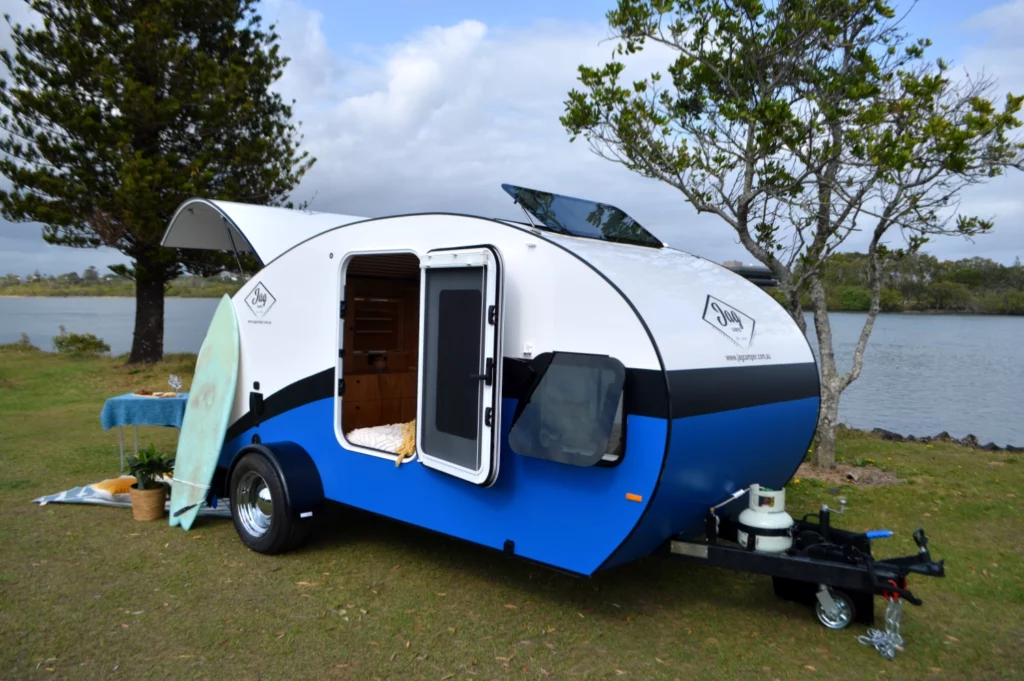
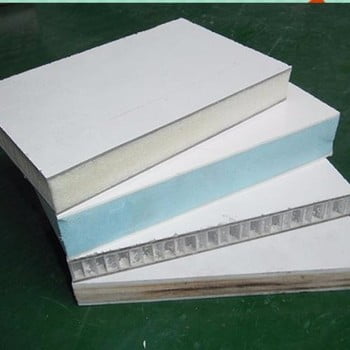
Pros
Strength and Durability
Engineered for exceptional strength, composite panels provide the most robust and durable structure for teardrop campers. This construction method ensures longevity and resilience, making it a suitable choice for campers seeking a reliable and long-lasting investment. There are many different types of composite panels to choose from, each one excelling in certain use cases.
Lightweight
Similar to fiberglass, composite panels offer the advantage of being lightweight. This characteristic strikes a balance between strength and mobility, contributing to enhanced fuel efficiency and easier towing. Campers can enjoy the benefits of a sturdy build without compromising on maneuverability.
Insulation
One of the standout features of composite panels is the often-included built-in insulation. This provides campers with improved temperature control inside the camper, making it suitable for varied climates. The insulation ensures comfort during all seasons, enhancing the overall camping experience.
Cons
Limited Customisation
While composite panels offer structural benefits, customization options may be somewhat limited compared to wood construction. Achieving intricate or highly personalized designs may pose challenges, and campers may need to find a balance between structural integrity and customization. In saying this there is more ability for customisation than fibreglass mould constructed teardrops.
Cost
The initial investment for composite panel construction can be higher than other methods. However, considering the long-term benefits, such as durability and insulation, the higher upfront cost may be justified for those seeking a camper with advanced features and a focus on long-term value.
Repair Complexity
Repairs to composite panels may require specific skills and materials. While these panels are robust, addressing damage may involve more complexity compared to the repair processes of wood construction. This consideration underscores the importance of factoring in potential repair costs and the availability of skilled professionals when opting for composite panel construction.
Materials Used in the JAG Camper – Standing Out From The Rest!
At JAG Camper we are committed to building the best teardrop campers in the world, and this all starts with careful material consideration.
XRP/FRP Panel Exterior Construction

For our exterior construction we utilise an XPS/FRP Composite Panels, which we believe are the absolute best for the job. These are the same type of panels that refrigerator cold store trucks and the top of the range luxury caravan builders utilise. They provide excellent durability against impact and all weather conditions. They do not degrade over time (unlike fibreglass and wood), meaning the JAG Camper is absolutely built to last. The panels are also extremely light weight, allowing for easy and fuel efficient towing by even the smallest vehicles of the market.
You may have noticed that the JAG Camper cabin is much larger and not as cramped as traditional teardrops! This is due to utilisation of these panel, allowing us to provide you with more space, without going over the towing capacity of small cars!
The amazing insulative properties of the panels also allow the JAG Camper to be used the hottest and coldest of climates with absolute comfort, unlike other teardrop builds.
These panels are more expensive to utilise than wood and fibreglass, but the durability and longetivity of the camper makes up for this very quickly.
Falcatta Plywood Cabinetry
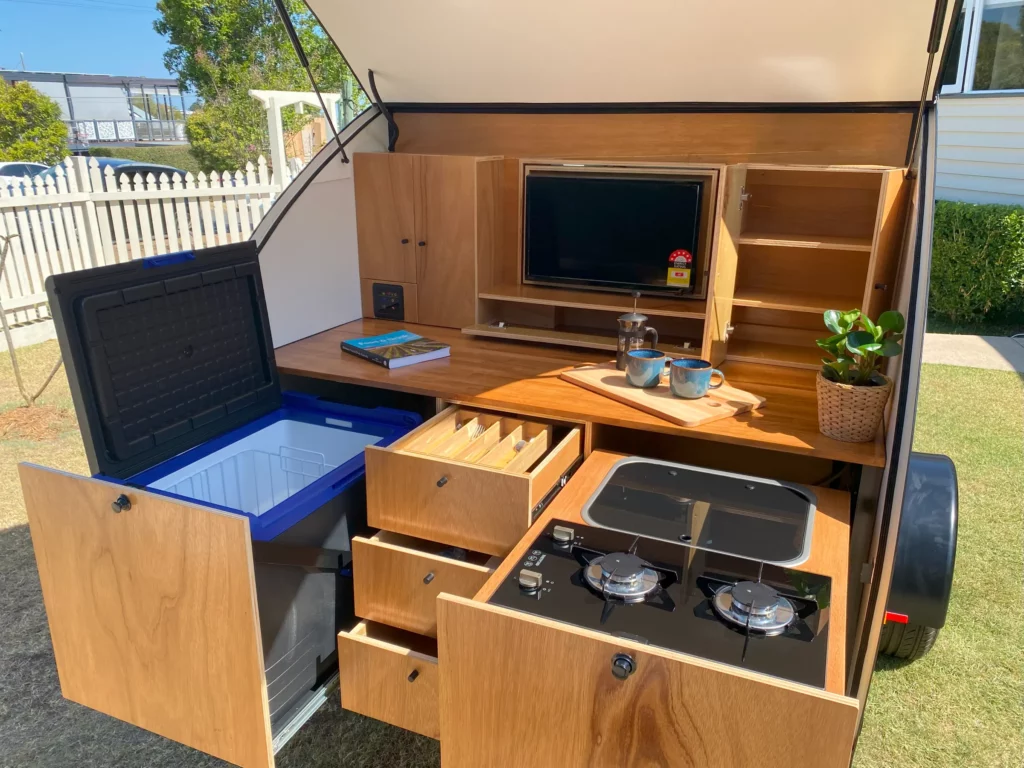
To maintain that unique, comfortable and warm feel of traditional caravans, we have used plywood timber for all of our cabinetry. This is no ordinary plywood though, it is Falcatta Plywood! Falcatta plywood is exceptionally lightweight for a hardwood, reducing the overall weight of the camper. The cabinetry is also sealed with a water based Cabothane sealant product, ensuring durability and protection against rot. Falcatta is also the most environmentally friendly wood you can get, being an extremely fast growing tree and manufactured with Low formaldehyde containing glue (so there are no nasty chemicals in your camper).
Conclusion
Selecting the right teardrop camper construction method involves a thorough evaluation of the multifaceted aspects of each option. Whether captivated by the classic charm of wood, enticed by the lightweight properties of fiberglass, or drawn to the strength and insulation of composite panels, understanding the nuances of each method empowers builders to embark on their camper construction journey with confidence. Ultimately, the choice should align with individual camping styles.





